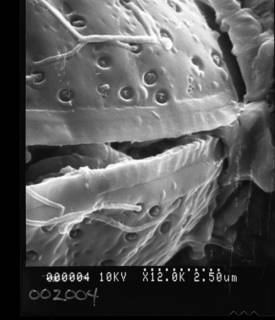
| Home | | Literature | | Log in |
| Diatoms | | Haptophytes | | Dinoflagellates | | Raphidophyceans | | Dictyochophyceans | | Pelagophyceans | | Cyanobacteria | | Greylist | | Harmful non-toxic |
HABs taxon detailsProrocentrum mexicanum Osorio-Tafall, 1942
231885 (urn:lsid:marinespecies.org:taxname:231885)
accepted
Species
marine,
Not documented
Harmful effect P. mexicanum is included in Lassus et al.(2016) as harmful. It is mentioned as producing haemolytic toxins of unknown...
Harmful effect P. mexicanum is included in Lassus et al.(2016) as harmful. It is mentioned as producing haemolytic toxins of unknown nature. However, as the material on which this information is based is benthic, it is likely that the information relates to Prorocentrum rhathymum, not P. mexicanum. Lassus et al. (2016) further mention that P. mexicanum produces FAT. However, the information referred to is from a congress abstract and the organism was not identified further. Its identity is therefore somewhat uncertain (Tindall et al. 1981). True P. mexicanum needs to be refound and its harmful potential to be re-examined. [details] Taxonomy The species
Taxonomy The species
Guiry, M.D. & Guiry, G.M. (2024). AlgaeBase. World-wide electronic publication, National University of Ireland, Galway (taxonomic information republished from AlgaeBase with permission of M.D. Guiry). Prorocentrum mexicanum Osorio-Tafall, 1942. Accessed through: Lundholm, N.; Churro, C.; Escalera, L.; Fraga, S.; Hoppenrath, M.; Iwataki, M.; Larsen, J.; Mertens, K.; Moestrup, Ø.; Murray, S.; Tillmann, U.; Zingone, A. (Eds) (2009 onwards) IOC-UNESCO Taxonomic Reference List of Harmful Micro Algae at: https://www.marinespecies.org/hab/aphia.php?p=taxdetails&id=231885 on 2024-07-30
Lundholm, N.; Churro, C.; Escalera, L.; Fraga, S.; Hoppenrath, M.; Iwataki, M.; Larsen, J.; Mertens, K.; Moestrup, Ø.; Murray, S.; Tillmann, U.; Zingone, A. (Eds) (2009 onwards). IOC-UNESCO Taxonomic Reference List of Harmful Micro Algae. Prorocentrum mexicanum Osorio-Tafall, 1942. Accessed at: https://www.marinespecies.org/hab/aphia.php?p=taxdetails&id=231885 on 2024-07-30
Date action by
additional source
Guiry, M.D. & Guiry, G.M. (2024). AlgaeBase. <em>World-wide electronic publication, National University of Ireland, Galway.</em> searched on YYYY-MM-DD., available online at http://www.algaebase.org [details]
additional source Tomas, C.R. (Ed.). (1997). Identifying marine phytoplankton. Academic Press: San Diego, CA [etc.] (USA). ISBN 0-12-693018-X. XV, 858 pp., available online at http://www.sciencedirect.com/science/book/9780126930184 [details] additional source Zenetos, A.; Çinar, M.E.; Pancucci-Papadopoulou, M.A.; Harmelin, J.-G.; Furnari, G.; Andaloro, F.; Bellou, N.; Streftaris, N.; Zibrowius, H. (2005). Annotated list of marine alien species in the Mediterranean with records of the worst invasive species. <em>Mediterranean Marine Science.</em> 6 (2): 63-118., available online at https://www.researchgate.net/publication/273213810_Annotated_list_of_marine_alien_species_in_the_Mediterranean_with_records_of_the_worst_invasive_species [details] Available for editors additional source Steidinger, K. A., M. A. Faust, and D. U. Hernández-Becerril. 2009. Dinoflagellates (Dinoflagellata) of the Gulf of Mexico, Pp. 131–154 in Felder, D.L. and D.K. Camp (eds.), Gulf of Mexico–Origins, Waters, and Biota. Biodiversity. Texas A&M Press, College [details] additional source Zenetos, A.; Meriç, E.; Verlaque, M.; Galli, P.; Boudouresque, C.-F.; Giangrande, A.; Cinar, M.; Bilecenoglu, M. (2008). Additions to the annotated list of marine alien biota in the Mediterranean with special emphasis on Foraminifera and Parasites. <em>Mediterranean Marine Science.</em> 9(1): 119-165., available online at https://doi.org/10.12681/mms.146 [details] Available for editors  Present Present  Inaccurate Inaccurate  Introduced: alien Introduced: alien  Containing type locality Containing type locality
From regional or thematic species database
Description Clearly distinct from P. rhathymum, according to Cortés-Altamirano and Sierra-Beltrán (2003). Cells 30–40 μm in length and 20–30 μm in width. Valval pores radiating and a line of pores along the margins. From Lassus et al. 2016.[details] Harmful effect P. mexicanum is included in Lassus et al.(2016) as harmful. It is mentioned as producing haemolytic toxins of unknown nature. However, as the material on which this information is based is benthic, it is likely that the information relates to Prorocentrum rhathymum, not P. mexicanum. Lassus et al. (2016) further mention that P. mexicanum produces FAT. However, the information referred to is from a congress abstract and the organism was not identified further. Its identity is therefore somewhat uncertain (Tindall et al. 1981). True P. mexicanum needs to be refound and its harmful potential to be re-examined. [details] Taxonomy The species |



